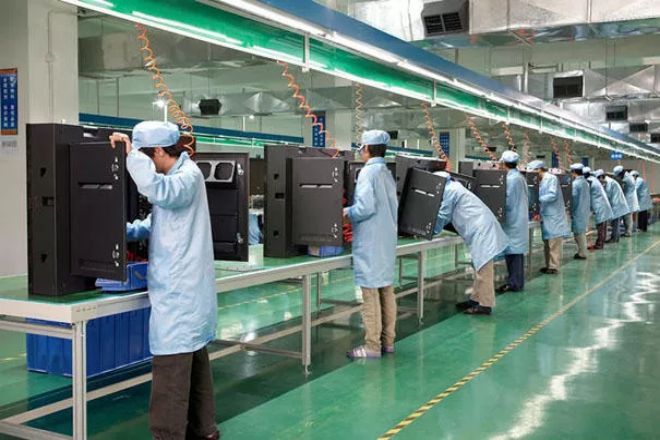Introduction

With the advancement of technology, indoor LED displays have been widely used in various occasions, such as shopping malls, hotels, conference centers, etc. However, for consumers, choosing a suitable indoor LED display is not an easy task because its price is affected by many factors. This article will delve into the main factors that affect the price of indoor LED displays.
1.Hardware cost

- LED chip:
The LED chip is the key to determining the brightness, color, and life of the display screen. Although high-quality imported chips are better than domestic chips in performance, their prices are also relatively high.
For example, although an imported brand of LED chips has high brightness and good color reproduction, its price per piece is more than twice that of domestic chips.
- Driver IC:
The driver IC is responsible for controlling the brightness and color of the LED. High-performance driver ICs can ensure stable operation of the display and reduce failure rates. However, the price of high-quality driver IC is relatively high.
For example, the price of a well-known brand’s driver IC is about 30% higher than that of other similar products due to its excellent performance and stability.
- Module and box:
Module and box are the basic structures of LED display screens. The use of different materials, such as aluminum alloy, steel, or plastic, as well as advanced surface treatment technology, will affect its price.
For example, a certain module and box made of aluminum alloy is still favored by many high-end projects because of its high strength, lightness, and good heat dissipation performance. Although the price is higher, it is still favored by many high-end projects.
- Control system:
The control system is the “brain” of the LED display. The type and performance of the control card determine the response speed, synchronization, and controllability of the display. The price of high-definition and high frame rate control cards is naturally higher than that of ordinary control cards.
The prices of sending cards and receiving cards are also different. Sending cards are usually more expensive than receiving cards because they integrate more functions and performance.
2. Production costs

Labor costs: The wages of skilled workers are significantly higher than those of junior workers. Their rich experience and high efficiency can ensure the quality and stability of products. In addition, overtime wages are different from wages for regular working hours, which will also have an impact on production costs.
Raw material procurement: Buying in bulk often results in lower prices because suppliers enjoy the benefits of economies of scale. However, fluctuations in international markets may lead to increases or decreases in raw material prices, thereby affecting production costs.
3. Freight cost

- Quality testing:
In order to ensure the quality of products, companies need to conduct multiple tests. The investment in quality testing equipment is a considerable expense, and the processing and reuse of defective products also require a certain amount of cost.
- Logistics and warehousing costs:
There are costs associated with transporting products, renting or purchasing warehousing facilities, and inventory management. In addition, the choice of logistics method will also affect costs. For example, the cost of shipping by land, air, or sea varies. Warehousing involves warehouse rent, equipment depreciation, personnel wages, and other expenses.
- Freight cost:
For large indoor LED displays, the transportation cost from the manufacturer to the customer is a considerable expense. Factors such as different transportation methods (such as land transportation, air transportation, and sea transportation), transportation distance, and whether special packaging is required will affect the freight cost.
In addition, if customers are located in different regions or countries, additional costs such as customs duties and VAT need to be considered.
4. Market factors
- Industry competition:
Analysis of the price strategies of competitors in the industry and the competition of new companies entering the market will have an impact on the price of indoor LED displays. When market competition is fierce, companies may adopt more favorable price strategies in order to maintain market share.
In addition, new companies entering the market may also adopt low-price strategies in order to open up the market, which is a challenge for existing companies.
- Market demand:
Market demand is also an important factor affecting the price of indoor LED displays. When market demand is strong, companies may increase prices; when market demand is low, companies may adopt price reduction strategies to attract customers.
In addition, factors such as consumer purchasing habits and brand loyalty will also affect market demand, thereby affecting the price of indoor LED displays.
- Technological progress:
With the continuous advancement of technology, the performance and quality of indoor LED displays continue to improve, but at the same time, their price has dropped.
Advances in technology not only help reduce production costs but also help increase the added value of products, thereby enhancing the competitiveness of enterprises. Therefore, technological progress has a positive impact on the price of indoor LED displays.
Conclusion
As mentioned above, the cost of indoor LED displays is actually composed of many factors, and it is not just the case of indoor LED displays. So choosing a good supplier is very important for buyers.
BIBILED is a professional supplier that has been in the display industry for 10 years,and its products are exported to 73 countries. If you want to know more about us, please contact us!
